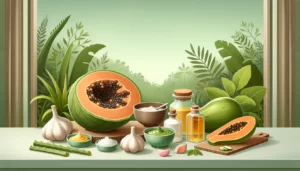Home Remedies for Lice Removal: Safe, Natural Solutions That Work (2025 Guide)
Estimated reading time: 10 minutes
Key Takeaways
- Natural remedies like tea tree oil and coconut oil offer safe alternatives to chemical treatments for lice removal.
- Wet combing is essential alongside any remedy to physically remove lice and nits.
- Consistency and patience are key—most treatments require repeated applications over 1-2 weeks.
- Prevention through hygiene and natural repellents can reduce re-infestation risks.
- Always prioritize safety with patch tests and proper dilution of essential oils.
Table of Contents
- Introduction to Lice Removal Challenges and Natural Solutions
- Understanding Head Lice: Causes, Symptoms, and Spread
- Do Home Remedies Work? Setting Realistic Expectations
- Top 7 Safe and Effective Home Remedies for Lice Removal
- Essential Tools and Techniques for Lice Removal
- Safety Precautions When Using Home Remedies
- Preventing Lice Re-Infestation Naturally
- When Home Remedies Aren’t Enough: Next Steps
- Frequently Asked Questions (FAQs) About Lice Removal
Introduction to Lice Removal Challenges and Natural Solutions
Dealing with head lice can be a frustrating ordeal, especially for families with young children. The constant itching and embarrassment often leave parents desperate for a solution. At WikiHomeRemedies, we understand this struggle and are here to guide you through safe, natural ways to tackle lice in 2025 with updated, research-backed insights.
Our purpose is simple: to offer effective home remedies that prioritize your family’s well-being. With lice infestations affecting an estimated 6 to 12 million children annually in the U.S., according to the CDC, this is a widespread concern. We draw on trusted sources like the NIH and Mayo Clinic to ensure our recommendations are grounded in science, aligning with WikiHomeRemedies’ commitment to reliable, natural health solutions. Let’s explore what lice are and how nature’s remedies can help restore comfort to your home. For more insights on natural solutions for other pesky issues, check out our guide on managing household pests: managing household pests.
Understanding Head Lice: Causes, Symptoms, and Spread
What Are Head Lice and How Do They Affect Us?
Head lice are tiny parasitic insects that live on the human scalp, surviving by feeding on small amounts of blood. These pests go through a life cycle starting as eggs, or nits, hatching into nymphs, and maturing into adults within a few weeks. While they don’t carry diseases, their presence can cause significant discomfort.
You might notice symptoms such as:
- Persistent itching, especially behind the ears or at the nape of the neck.
- Redness or irritation from scratching.
- Visible nits or lice in the hair, often near the scalp.
Understanding this cycle helps in targeting them at every stage. It’s the first step to choosing the right approach for removal, ensuring you address both lice and their eggs effectively. If you’re dealing with other skin irritations, explore our natural solutions for fleas and bites: natural solutions for fleas and bites.
How Do Head Lice Spread?
Lice spread primarily through direct head-to-head contact, a common occurrence among children during play or group activities. They can also transfer via shared items like combs, hats, or bedding, thriving in environments such as schools or summer camps. The CDC notes that school settings often report frequent outbreaks, making vigilance essential.
Picture a classroom where kids share a costume hat during a play—this is a perfect scenario for lice to hitch a ride. Knowing these risks helps you take proactive steps. By limiting sharing of personal items, you can reduce the chances of an infestation taking hold in your household.
Why Opt for Natural Home Remedies?
Natural remedies offer a gentle path to lice removal, especially appealing for parents wary of chemical treatments. Unlike over-the-counter pesticides, which studies from the NIH show lice are increasingly resistant to, natural options pose fewer risks of irritation or side effects. They’re often more affordable and align with a desire for non-toxic solutions.
For children with sensitive skin or families seeking sustainable choices, these methods provide peace of mind. They allow you to address the problem without exposing your loved ones to harsh substances. Let’s dive into how effective these solutions can be when applied with care. For additional natural care tips for pets with similar parasitic issues, see our guide on flea remedies for dogs: flea remedies for dogs.
Do Home Remedies Work? Setting Realistic Expectations
When it comes to natural lice removal, hope and patience go hand in hand. Research, including studies from PubMed, supports the use of remedies like tea tree oil for its antimicrobial strength or coconut oil for its ability to smother lice. These methods show promise, especially when paired with consistent effort.
Yet, let’s be clear—they’re not an overnight fix. Consider these points:
- Most remedies need repeated applications over days or weeks to break the lice life cycle.
- Manual removal through combing remains essential alongside treatments.
- Success often depends on diligence and thoroughness in targeting both lice and nits.
A combined approach works best. Using a natural treatment to weaken or kill lice, followed by wet combing, maximizes your chances of clearing the infestation. Understanding this balance prepares you for the practical steps ahead.
Top 7 Safe and Effective Home Remedies for Lice Removal
1. Tea Tree Oil Treatment
Tea tree oil stands out for its natural insecticidal and antimicrobial properties. Research, including a 2012 Australian study, suggests it can disrupt lice survival when used properly. It’s a favored choice for those seeking a potent yet gentle remedy.
Here’s how to apply it:
- Mix 5-10 drops of tea tree oil with 2 tablespoons of a carrier oil like coconut oil.
- Massage into the scalp and hair, covering all areas, and leave for 30 minutes.
- Comb through with a fine-tooth comb to remove lice and nits, then rinse thoroughly.
Always dilute the oil to prevent irritation, and do a patch test on a small skin area first. Avoid ingestion or contact with eyes. This method works well with consistent combing, ensuring no pests are left behind.
2. Coconut Oil Suffocation Method
Coconut oil offers a simple way to tackle lice by suffocating them and loosening nits from hair strands. Many parents report success with this accessible pantry item. Its thick texture creates a barrier that lice struggle to survive.
Try this process:
- Warm a generous amount of coconut oil and coat the hair completely.
- Cover with a shower cap and leave overnight to maximize effect.
- In the morning, comb out dead lice and nits, then wash the hair.
The warmth helps the oil penetrate better, easing application. Pair this with regular combing sessions across a week. It’s a soothing option that also leaves hair feeling soft.
3. Vinegar Rinse (Apple Cider or White)
Vinegar, whether apple cider or white, has long been used to help dissolve the glue that binds nits to hair. While not a standalone killer of lice, it supports removal by making combing more effective. Traditional practices back its role as a helpful aid.
Follow these steps:
- Mix equal parts vinegar and water to create a mild rinse.
- Apply to the scalp and hair, leaving it on for 15-20 minutes.
- Comb through, then wash out with regular shampoo.
Repeat every 2-3 days for a week to target lingering eggs. It’s a cost-effective choice that complements other treatments. Keep it gentle to avoid scalp dryness over time.
4. Neem Oil Application
Neem oil, rooted in Ayurvedic traditions, carries insecticidal qualities that interfere with lice reproduction. Small studies highlight its potential to weaken these pests. It’s a lesser-known but intriguing option for natural lice control.
Use it like this:
- Blend 5-10 drops of neem oil with a carrier oil or add to your shampoo.
- Apply to the scalp, ensuring full coverage, and rinse after 20 minutes.
- Comb out any remaining lice or nits post-treatment.
Source pure neem oil from trusted suppliers for best results. Be mindful of its strong scent, which some may find off-putting. It pairs well with ongoing prevention routines.
5. Lavender Oil Blend
Lavender oil is often praised for repelling lice while calming the scalp with its soothing nature. Though studies are limited, its use in aromatherapy circles suggests a protective effect. It’s a pleasant addition to any natural regimen.
Here’s a blend to try:
- Combine 10 drops of lavender oil with 2 tablespoons of olive oil.
- Spread evenly through hair, let sit for 30 minutes, then comb thoroughly.
- Rinse out and repeat as needed over several days.
Take care with young children or sensitive skin, testing a small amount first. This remedy doubles as a calming experience during a stressful infestation. It’s a bridge to ongoing repellent strategies.
6. Olive Oil Overnight Treatment
Olive oil works similarly to coconut oil by smothering lice, disrupting their ability to breathe. Many households swear by its effectiveness, drawn from years of traditional use. Beyond lice removal, it nourishes the scalp.
Apply it this way:
- Saturate the hair with olive oil until fully coated.
- Cover with a cap and leave on overnight for maximum impact.
- Comb out in the morning, then wash with shampoo.
This method suits those comfortable with longer treatment times. It’s a straightforward process, often already in your kitchen. Consistent follow-up combing ensures no stragglers remain.
7. Mayonnaise Mask
Mayonnaise might sound unconventional, but its dense texture is thought to suffocate lice effectively. Parenting communities often share stories of success with this quirky remedy. It’s widely available, though not the tidiest option.
Here’s how to use it:
- Spread a thick layer of mayonnaise over the hair, covering every strand.
- Wrap with a cap or plastic wrap and leave for 8 hours.
- Rinse thoroughly and comb out lice and nits.
While easy to source, it can be messy to clean up. Weigh the convenience against the effort. It aligns with other suffocation techniques for a varied approach.
Essential Tools and Techniques for Lice Removal
Wet Combing Method: A Crucial Step
Wet combing stands as the cornerstone of lice removal, directly pulling out both pests and eggs with a fine-tooth comb. It’s a method backed by practicality, requiring no chemicals, just persistence. Breaking the life cycle hinges on this hands-on approach.
Follow this guide:
- Wet the hair and apply a generous amount of conditioner to ease combing.
- Section the hair and comb from scalp to ends with a nit comb, wiping after each pass.
- Repeat every 2-3 days for two weeks to catch newly hatched lice.
Tools like the Nit Free Terminator Comb, widely available, offer precision with closely spaced teeth. Make this a routine after any remedy. It’s labor-intensive but vital for thorough clearing.
Integrating Combing with Natural Remedies
Pairing wet combing with natural treatments amplifies results significantly. Oils or rinses loosen nits and weaken lice, making them easier to extract during combing sessions. This synergy turns a good effort into a great one.
After applying a remedy like coconut or olive oil, comb while the hair is still coated to capture stunned or dead lice. Conditioner post-treatment keeps strands manageable for repeated passes. This combination ensures you’re attacking the problem from multiple angles, enhancing overall success.
Safety Precautions When Using Home Remedies
While natural remedies offer gentler paths, they still demand caution to protect your family. Essential oils, though derived from plants, can trigger reactions if mishandled. WikiHomeRemedies urges care to keep this journey safe.
Consider these tips:
- Always perform a patch test on skin before full scalp application, especially with oils like tea tree or neem.
- Dilute properly to avoid irritation—follow suggested ratios and keep solutions away from eyes.
- Avoid using potent oils on infants, pregnant individuals, or those with specific health conditions.
If irritation or persistent lice occur, consult a healthcare provider, as recommended by pediatric guidelines and WHO safety notes. Scalp infections or allergies need professional attention. Stay informed to ensure remedies heal, not harm. For related skin sensitivity concerns, read our tips on managing pet allergies naturally: managing pet allergies naturally.
Preventing Lice Re-Infestation Naturally
Personal Hygiene and Behavioral Tips
Stopping lice from returning begins with small, mindful habits in daily life. Teaching your family these practices can shield against future outbreaks. Prevention feels empowering when it’s within your control.
Try these steps:
- Discourage sharing combs, hats, or headphones, especially among children.
- Remind kids to avoid head-to-head contact during play or sports.
- Tie long hair back in tight braids or buns in crowded settings like school.
In places where closeness is inevitable, such as during a school project, these habits make a difference. Stay consistent with these routines. They form a strong first line of defense alongside other measures.
Household Cleaning Guide
A clean environment disrupts lice survival away from the scalp, cutting re-infestation risks. Lice can linger on fabrics or surfaces for a short time, so tackling your home is key. Follow proven steps to ensure they’re gone for good.
Take action with:
- Wash bedding, clothes, and stuffed toys in hot water at 130°F (54°C), then dry on high heat.
- Vacuum carpets, upholstered furniture, and even car seats thoroughly.
- Soak combs and brushes in hot water or a vinegar solution for 10 minutes.
The CDC supports these cleaning practices to eliminate stray lice or nits. Make this a thorough sweep after treatment. A clean space supports your efforts on the scalp.
Natural Repellents for Ongoing Protection
Natural repellents offer a shield against lice returning to treated hair or belongings. Essential oils provide a subtle, ongoing barrier with minimal effort. They’re a practical extension of your removal strategy.
Consider this recipe:
- Mix 10 drops of tea tree or peppermint oil with 8 ounces (240 ml) of water in a spray bottle.
- Lightly mist hair or backpacks daily, avoiding overuse near the face.
- Check scalps weekly, especially after known exposures at school.
Many families note success with such sprays, though evidence remains anecdotal. This habit pairs well with earlier remedies. It keeps vigilance gentle and rooted in nature’s offerings.
When Home Remedies Aren’t Enough: Next Steps
Recognizing Persistent Infestation Signs
Sometimes, despite your best efforts, lice cling on stubbornly. Recognizing when natural methods fall short helps you shift gears wisely. Stay observant to know when extra help is needed.
Watch for these clues:
- Ongoing itching or new red spots from scratching after two weeks of treatment.
- Visible lice or fresh nits still present in hair despite consistent remedies.
- Signs of scalp infection, like oozing or severe tenderness.
Monitoring post-treatment keeps surprises at bay. If these persist, it’s a signal to explore other paths. Acting promptly prevents prolonged discomfort for your family.
Over-the-Counter and Professional Options
When natural remedies don’t fully resolve the issue, alternative solutions await. Over-the-counter treatments like permethrin or pyrethrin shampoos, as noted by the Mayo Clinic, serve as backups. They target resistant lice with medicated precision.
For tougher cases, professional lice removal services offer hands-on help, or a pediatrician can guide on stronger prescriptions. While WikiHomeRemedies champions natural first steps, we recognize these options as valid when needed. Always prioritize safety and consult experts to find the right fit for persistent challenges. For other persistent pet-related parasite issues, explore our guide on managing dog ear mites naturally: managing dog ear mites naturally.
Frequently Asked Questions (FAQs) About Lice Removal
Can home remedies completely get rid of lice?
They can, with persistence. Remedies like tea tree oil or coconut oil weaken lice, but combing remains crucial to remove every last one. Combine treatments with diligence over two weeks for lasting results.
How long does it take for natural treatments to work?
Expect a timeline of 1-2 weeks with daily or frequent applications. Lice and nits need repeated targeting due to their life cycle. Consistency speeds up clearing the infestation.
Are essential oils safe for young children?
They can be, if diluted properly and patch-tested first. Avoid strong oils like tea tree on infants or toddlers without a doctor’s input. Safety always comes before application.
How can I tell if the lice are gone?
Check for no itching, no visible lice, and no new nits near the scalp after two weeks. Comb regularly during this period as a final sweep. Absence of these signs means success.
What’s the fastest natural remedy for lice?
Suffocation methods like coconut or olive oil often show quicker visible impact when left overnight. Pair with immediate combing for speed. Repeat as needed to catch stragglers.










